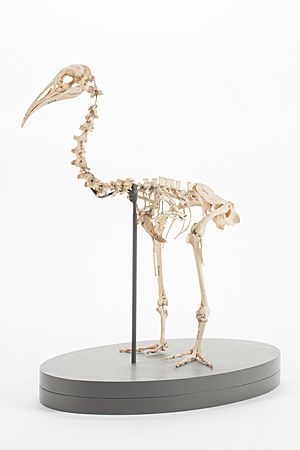Hawkins's rail facts for kids
Quick facts for kids Hawkins's railTemporal range: Holocene
|
|
|---|---|
 |
|
| Skeleton from the collection of Auckland Museum | |
| Conservation status | |
| Scientific classification | |
| Genus: |
Diaphorapteryx
|
| Species: |
hawkinsi
|
The Hawkins' rail or the giant Chatham Island rail (Diaphorapteryx hawkinsi) was a large, flightless bird. It is now extinct, meaning it no longer exists. This unique bird lived only on the Chatham Islands, which are located east of New Zealand. Specifically, it was found on the main islands of Chatham Island and Pitt Island.
Hawkins' rail was the biggest land bird on the Chatham Islands. It stood about 40 centimeters (16 inches) tall and weighed around 2 kilograms (4.4 pounds). It had a long beak that curved downwards. Local stories from the Moriori people, who lived on the islands, called this bird the Mehonui. They described it as reddish-brown. It likely behaved like the weka, using its strong beak to search for insects in rotting wood. Scientists believe Hawkins' rail became extinct because the Moriori people hunted it. Its bones have been found in their old kitchen middens (trash piles).
Contents
Discovering Hawkins' Rail
In 1892, a scientist named Henry Ogg Forbes received some unusual fossil bones from the Chatham Islands. Among them was a special skull. Forbes quickly realized it belonged to a new, extinct type of rail. He named it Aphanapteryx hawkinsi to honor William Hawkins, who sent the bones. At first, Forbes thought it was related to the red rail from the island of Mauritius. He even thought there might have been a land bridge connecting these far-apart islands long ago!
Later, in 1893, Forbes decided to place Hawkins' rail in its own separate group, called Diaphorapteryx. This name is still used today. Between 1894 and 1895, many more bones of Hawkins' rail were collected.
Evolution
Scientists used DNA from the bones to learn more about Hawkins' rail. A study in 2014 found that its closest living relative is the invisible rail (Habroptila wallacii). This bird lives far away on the island of Halmahera in Indonesia. These two birds shared a common ancestor about 10 million years ago. Both of them are also related to the Gallirallus group of rails.
What Hawkins' Rail Looked Like
Skeleton
Hawkins' rail was a sturdy bird. It stood about 40 centimeters (16 inches) tall and weighed around 2 kilograms (4.4 pounds). Its wings were very small, meaning it could not fly. Its legs were strong, and its toes were long. The most noticeable feature was its long beak, which curved downwards. This strong beak was likely used for digging.
Stories from the Past
European explorers did not see Hawkins' rail alive. For a long time, people thought it died out hundreds of years before Europeans arrived in the early 1800s. However, old stories from the Moriori people, who called the bird Mehonui, suggest it might have lived much longer.
In 1895, a letter described the bird's look and behavior, and how the Moriori hunted it. The Moriori said the "Mehonui" was bigger than a goose and had a very loud call, like "Tue-ck." It often walked with its head down, pecking in rotting wood on the ground. They could sometimes catch them by walking straight up to them from the front. The birds would sleep together in groups. The Moriori would find these sleeping spots, sneak up quietly, and then rush to catch the whole group. They described the bird as a dull brick-red color.
Another story from 1911 also mentioned the Mehonui. It said the bird was caught at its sleeping place, where several birds (six or eight) would huddle together. The Moriori would clear paths to these spots to avoid making noise. If someone approached the bird from the front, it often didn't see them. This allowed hunters to grab its neck. However, if someone came from the side or behind, the bird would quickly notice and run away. Its color was reddish-brown, similar to the kaka parrot.
These stories suggest that Hawkins' rail was a dull brick-red color. It spent a lot of time searching for food, like insects, in decaying wood. This is similar to how weka birds behave. The loud "Tue-ck" sound was probably a contact call to communicate with other birds. The "colonies" mentioned in the stories were likely family groups during breeding season. Because of its strong beak, it might have eaten many different things, including the chicks of ground-nesting birds like petrels.
Why Hawkins' Rail Disappeared
The detailed stories from the late 1800s suggest that Hawkins' rail became extinct more recently than scientists first thought. It seems they survived long after the Moriori people first arrived on the islands. We know the Moriori hunted these birds because their bones are found in old middens (ancient trash piles).
While the stories don't say how often the birds were hunted, targeting their breeding groups (which included both adult and young birds) would have had a big impact on their numbers. If some Hawkins' rails were still alive when Europeans arrived, they might have finally died out because of new animals brought to the islands. These animals included cats, dogs, rats, and pigs, which arrived before the first surveys of the islands in 1840.
Photo Gallery
-
Fossil bones from the collection of Auckland Museum
-
Leg and foot bones from the collection of Auckland Museum
-
Skeleton from the collection of Auckland Museum
See also
 In Spanish: Rascón de Hawkins para niños
In Spanish: Rascón de Hawkins para niños








